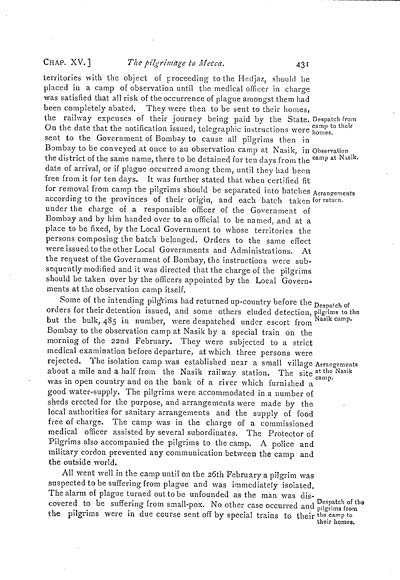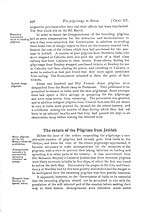Medicine - Disease > Plague in India, 1896, 1897 > Volume 1
(452) Page 431
Download files
Individual page:
Thumbnail gallery: Grid view | List view

CHAP. XV. ] The pilgrimage to Mecca. 431
Despatch from
camp to their
homes.
Observation
camp at Nasik.
Arrangements
for return.
territories with the object of proceeding to the Hedjaz, should he
placed in a camp of observation until the medical officer in charge
was satisfied that all risk of the occurrence of plague amongst them had
been completely abated. They were then to be sent to their homes,
the railway expenses of their journey being paid by the State.
On the date that the notification issued, telegraphic instructions were
sent to the Government of Bombay to cause all pilgrims then in
Bombay to be conveyed at once to an observation camp at Nasik, in
the district of the same name, there to be detained for ten days from the
date of arrival, or if plague occurred among them, until they had been
free from it for ten days. It was further stated that when certified fit
for removal from camp the pilgrims should be separated into batches
according to the provinces of their origin, and each batch taken
under the charge of a responsible officer of the Government of
Bombay and by him handed over to an official to be named, and at a
place to be fixed, by the Local Government to whose territories the
persons composing the batch belonged. Orders to the same effect
were issued to the other Local Governments and Administrations. At
the request of the Government of Bombay, the instructions were sub-
sequently modified and it was directed that the charge of the pilgrims
should be taken over by the officers appointed by the Local Govern-
ments at the observation camp itself.
Despatch of
pilgrims to the
Nasik camp.
Arrangements
at the Nasik
camp.
Some of the intending pilgrims had returned up-country before the
orders for their detention issued, and some others eluded detection,
but the bulk, 485 in number, were despatched under escort from
Bombay to the observation camp at Nasik by a special train on the
morning of the 22nd February. They were subjected to a strict
medical examination before departure, at which three persons were
rejected. The isolation camp was established near a small village
about a mile and a half from the Nasik railway station. The site
was in open country and on the bank of a river which furnished a
good water-supply. The pilgrims were accommodated in a number of
sheds erected for the purpose, and arrangements were made by the
local authorities for sanitary arrangements and the supply of food
free of charge. The camp was in the charge of a commissioned
medical officer assisted by several subordinates. The Protector of
Pilgrims also accompanied the pilgrims to the camp. A police and
military cordon prevented any communication between the camp and
the outside world.
Despatch of the
pilgrims from
the camp to
their homes.
All went well in the camp until on the 26th February a pilgrim was
suspected to be suffering from plague and was immediately isolated.
The alarm of plague turned out to be unfounded as the man was dis-
covered to be suffering from small-pox. No other case occurred and
the pilgrims were in due course sent off by special trains to their
Despatch from
camp to their
homes.
Observation
camp at Nasik.
Arrangements
for return.
territories with the object of proceeding to the Hedjaz, should he
placed in a camp of observation until the medical officer in charge
was satisfied that all risk of the occurrence of plague amongst them had
been completely abated. They were then to be sent to their homes,
the railway expenses of their journey being paid by the State.
On the date that the notification issued, telegraphic instructions were
sent to the Government of Bombay to cause all pilgrims then in
Bombay to be conveyed at once to an observation camp at Nasik, in
the district of the same name, there to be detained for ten days from the
date of arrival, or if plague occurred among them, until they had been
free from it for ten days. It was further stated that when certified fit
for removal from camp the pilgrims should be separated into batches
according to the provinces of their origin, and each batch taken
under the charge of a responsible officer of the Government of
Bombay and by him handed over to an official to be named, and at a
place to be fixed, by the Local Government to whose territories the
persons composing the batch belonged. Orders to the same effect
were issued to the other Local Governments and Administrations. At
the request of the Government of Bombay, the instructions were sub-
sequently modified and it was directed that the charge of the pilgrims
should be taken over by the officers appointed by the Local Govern-
ments at the observation camp itself.
Despatch of
pilgrims to the
Nasik camp.
Arrangements
at the Nasik
camp.
Some of the intending pilgrims had returned up-country before the
orders for their detention issued, and some others eluded detection,
but the bulk, 485 in number, were despatched under escort from
Bombay to the observation camp at Nasik by a special train on the
morning of the 22nd February. They were subjected to a strict
medical examination before departure, at which three persons were
rejected. The isolation camp was established near a small village
about a mile and a half from the Nasik railway station. The site
was in open country and on the bank of a river which furnished a
good water-supply. The pilgrims were accommodated in a number of
sheds erected for the purpose, and arrangements were made by the
local authorities for sanitary arrangements and the supply of food
free of charge. The camp was in the charge of a commissioned
medical officer assisted by several subordinates. The Protector of
Pilgrims also accompanied the pilgrims to the camp. A police and
military cordon prevented any communication between the camp and
the outside world.
Despatch of the
pilgrims from
the camp to
their homes.
All went well in the camp until on the 26th February a pilgrim was
suspected to be suffering from plague and was immediately isolated.
The alarm of plague turned out to be unfounded as the man was dis-
covered to be suffering from small-pox. No other case occurred and
the pilgrims were in due course sent off by special trains to their
Set display mode to: Large image | Zoom image | Transcription
Images and transcriptions on this page, including medium image downloads, may be used under the Creative Commons Attribution 4.0 International Licence unless otherwise stated. ![]()
| India Papers > Medicine - Disease > Plague in India, 1896, 1897 > Volume 1 > (452) Page 431 |
|---|
| Permanent URL | https://digital.nls.uk/74594596 |
|---|




